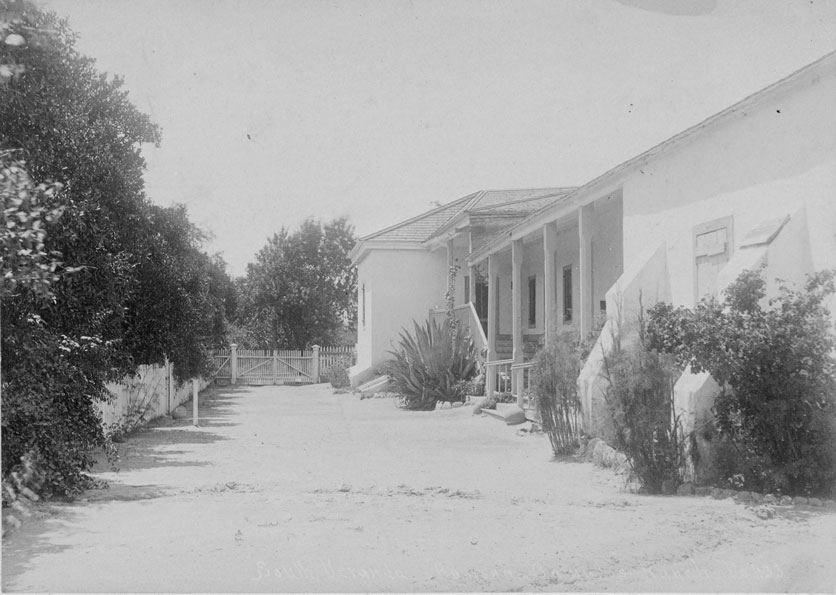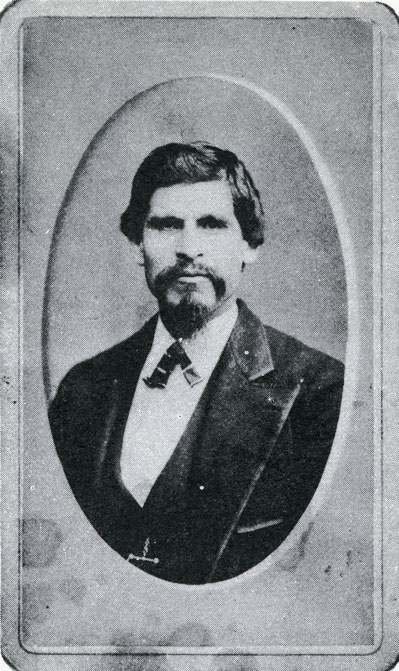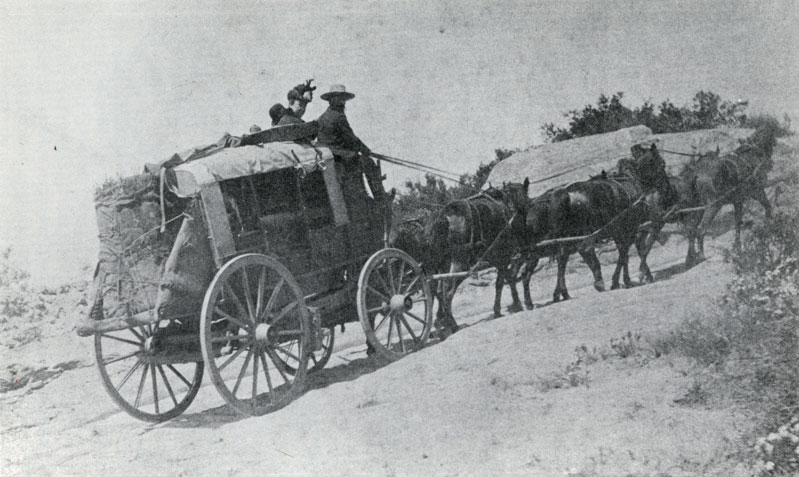Edited by Grant W. Heil
This month’s Journal Flashback presents an account of taking a stagecoach from Ventura, through the Santa Clara Valley, and through the back country of Soledad Canyon. What is now a simple ride down State Route 126 and up State Route 14, used to be a slow, and sometimes dangerous journey – there’s even an account of a robbery. The narrator changes throughout the article as it consists of excerpts taken from various published accounts by travelers in the Ventura Signal. This article was taken from MVC Quarterly Volume 19, Number 3 (Spring 1974).

21530 PC, MVC Library & Archives collection.
VENTURA TO SOLEDAD1
It was early morning when we drove out of Ventura. The sea and the great sentinels that guard the swelling waves were just throwing off their night robes of mist, and faintly came the sound of the dashing surf on the beach. But soon we ceased to hear what the wild waves were saying as we drove rapidly up the Santa Clara Valley. To one like myself, fresh from the prosaic prairies of Iowa and Illinois, the scenes about me were fascinating indeed. Towering above us on either side were mountains, scarred and rock-ribbed, which were of every shade of rich brown and soft silvery gray; those of the far off Sespe showing the deep royal purple. In the valley were waving cornfields of which any Illinois farmer might feel proud, and stacks of grain and ricks of hay.
After leaving Saticoy we passed neat cottages surrounded with beautiful trees and flowers. But this is not the season to see the orchards and gardens looking their prettiest unless they have been irrigated, as many in the valley have not. The inevitable dust continually reminded me of my mortality. “Earth to earth, and dust to dust” kept ringing in my ears, as in clouds like Pharaoh’s mist it came behind and like the cloudy pillar it went before; yet it did not destroy the beauty of the changing scenery, though I confess it marred it somewhat.
The little town of Santa Paula, which we reached early in the day, seems to be a growing town with a fine schoolhouse; and from what I could learn of its people, I think it must be a delightful place to live; it is far enough from the sea to escape heavy winds and is quite elevated. After a short rest we started again from Santa Paula, passing bands of sheep feeding on the stubble and clover burrs and a few pretty farmhouses nestled at the foot of the mountains and near the running creek. We also passed droves of cattle, hundreds in number, which proved to me that California is indeed rich in livestock. Just after noon we crossed the Sespe, the only stream worth the name of river I have seen in California. Just on the east bank, under the shade of a great sycamore, is Mr. F.A. Sprague’s hospitable house. His location is charming with its dense shade, prolific soil, and romantic surroundings; he has also an abundance of pure and comparatively cold water. I say comparatively, for I have as yet found no cold water in the state. The growth of vegetation in California seems past belief: on Mr. Sprague’s place there are grape vines of the tender varieties (Black Hamburg, Tokay, etc.) of two years growth, now hanging full of great clusters of grapes a foot long and weighing several pounds; a little grove of acacia trees near the house planted a year ago, which are now sixteen feet high; and a walnut tree, three years old, sends branches eighteen feet from the ground.
Early next morning we bade our new friends of the Sespe adieu, and soon were at the famous Camulos where inviting shade and delicious fruits tempted us to rest a few moments. A pretty daughter of Don Ygnacio del Valle, the owner and founder of the Camulos vineyard and orchard, acted as our guide as we passed through it. Here were golden oranges and lemons weighing down the branches of glossy green, great almond trees with their heavy burdens, grapes, pears, and fruits of all kinds. The roses have almost ceased to bloom.
But Soledad had to be reached before night, so I was forced to tear myself away from this delightful spot. On our way to Lyon’s Station, I saw but little signs of civilization, the great landholders being the cause. Late in the afternoon we stopped under the shade of a great live oak and found already another “weary traveller.” We were soon joined by three other teams from different directions: one driven by an Italian, another by a Mongolian2, and another by an American boy. It was a strange meeting of races. China stared stupidly while Italy talked eloquently and displayed a wonderful knowledge of this country. The Spanish-American talked with his eyes only, while young America, with true Yankee curiosity, attempted to discover the destination and business of each of us by shrewd questions. It was a strange intervention in life’s paths, a meeting of this nature without an intent in common. A few moments would carry us each on our separate paths. Truly this is a cosmopolitan country.
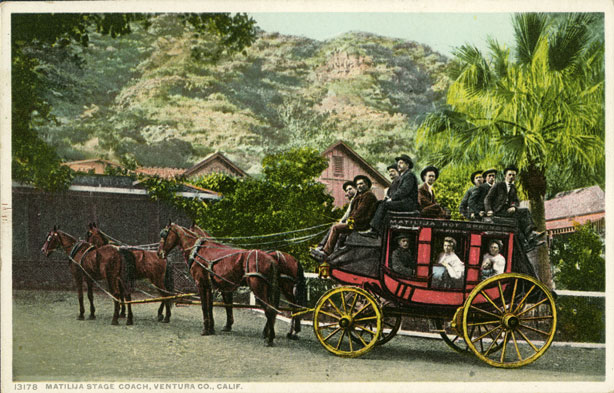
We soon drove on and quickly found ourselves at Lyon’s Station, a charmingly located place, at which there is a post office, telegraph office and hotel all in one. Here are also extensive oil works, and gold mines up the cañon. Great teams with their little chimes of musical bells, the daily stages with their four horses and dashing drivers are constantly passing this place, making it a lively one. Here were men from all parts of the United States and all nationalities, representing mining interests, etc. From here I took Sam Harper’s stage for Soledad, and this ride of twenty-eight miles was through the wildest and most picturesque scenery of our route. The road winding through cañons and over mountains, across dashing mountain streams and under dark spreading glossy-leaved live oaks. We were here in the vicinity of the haunts of the famous Vasquez3, where one might indeed expect to be called upon to halt and deliver. But no adventure of the kind occurred; and I am half sorry, for with the recounting of it I could have made this letter more interesting than it is. I rode in the moonlight, and was continually astonished at some new and unlooked for romantic feature in the ever-changing scenery.
A sudden curve brought us all suddenly into the little settlement called Soledad, which is nestled lovingly in a cañon at the foot of the mountain. On every side the voice is broken by great overhanging rocks, scarred and seared by time. On the south is a long, low flat bounded by a little flashing stream shaded by trembling-leafed cottonwoods, graceful willows and sturdy oaks (beyond the mountains again, a circle complete). One hotel, store, blacksmith shop, schoolhouse and a few dwellings constitute the remnant of a once flourishing mining settlement. So much I saw in the light of an August moon.
LYON’S STATION4
While at Lyon’s Station last week we visited the oil wells of that vicinity, satisfying ourselves of the truth in regard to the floating rumors of the immense source of wealth buried in the mountains at this point. Our party consisted of four in number, under the guidance of Captain Kraszynski, who has large interests in the Clara and Danbury claims located there. A carriage drive winds along the foot of the mountains and for some distance up the cañon where the oil springs first make their appearance. They are almost numberless, the oil spreading over the ground in all directions. This oil has been pronounced by experts to be of the finest quality. We were told the existence of these springs has been known for many years, the oil being bottled for medicinal purposes, without a suspicion of its being petroleum until quite recently. Here, under the branches of lofty trees, amid the silence and loneliness of nature, is one of the greatest resources of the wealth of southern California.
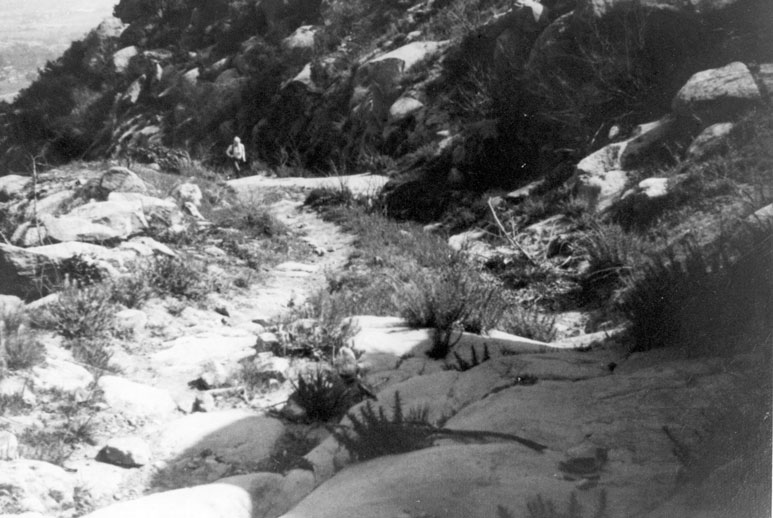
After proceeding up the cañon, as far as the drive would permit, we mounted on little ponies and rode up the narrow defile to the boiling springs which presented a very interesting appearance. The basins of the springs are several feet in diameter and in a state of violent ebullition as diabolical in appearance as the witches’ cauldron in Macbeth, needing but the presence of Hecate and her weird band to realize that horrible creation of poetic fancy.
We proceeded up this cañon for some miles, the scenery growing wilder at every turn. Vistas of light broke through the pines that crown the mountains towering above us on each side several hundred feet. Then the springs increased at every point, the oil oozing through the crevices of the rocks on every side. The water here is exceedingly bitter, and the ground fairly covered with the black tarry substance. Future developments will show the immense wealth of these springs. We were told by reliable parties Carreras had, by his new process of refining, realized forty percent from the B.S. (below standard) oil, showing it to be richer than even the Pennsylvania and West Virginia oils.
SOLEDAD CANYON5
By G.W. Coffin of the A.&P. R.R.
There may be many places one finds in the course of a lifetime that are soledad, or solitary (the true English of the word).6 But this particular one is worthy of more than passing notice as, at no distant day, it may become a place of so much life that a new name will be required. It may be as well to give the latitude and longitude (not so much to keep mariners from sailing into it as to benefit such of your readers as may wish to cross the Mojave Desert lying between here and the Colorado River): latitude 34½ north and longitude 118½ west. It is due east from Santa Barbara 81 miles and due north from Los Angeles 20 miles, straight lines in both cases of course. By wagon road from the coast of Ventura it is about 65 miles. Elevation 2,400 feet above tide water. It is a terminus of the Santa Clara Valley or more properly of the narrow cañon at the head of it, which is termed Soledad Pass. For twenty miles this pass is narrow and tortuous, the mountains on either side being high and irregular. After traversing this distance, it opens on the upper Santa Clara Valley at Lang’s and continues for ten miles when the valley proper commences.
Twelve miles from the desert at Barrel Springs and eight miles from the mouth of the pass at Lang’s are twelve or fifteen buildings that go to make up the town of Soledad. It is not an old town, not like the old Mexican towns with a mission and adobe houses with tile roofs. It is the offshoot of a mining town of 1,000 inhabitants that existed a few years ago, about two miles up the pass, called Ravenna. The last fragments of Ravenna gravitated this way, and Soledad began. Although it cannot boast a church, it has no prison but has a schoolhouse, two stores, a hotel, a blacksmith shop and nearby are two large quartz mills. There is quite a sprinkling of Mexicans in its population, among whom the name of Vasquez has most notoriety just now.
The traveler up the Santa Clara Valley will look in vain for a place where the immediate natural surroundings are more attractive than at Soledad. Cultivation, irrigation and much labor has made Camulos most delightful, but nature has done the same for Soledad. Here is a little senega,7 a half-mile wide and a mile and a half long, where a thousand springs of sweet, cold water bubble to the surface. Invited by the moisture the willow, buttonwood, and sycamore have spread their leafy canopies over the greensward, from which they draw their sustenance. Their cool shades invite the birds from the mountain’s barren sides, while bands of wild horses and mules with herds of gaunt, anxious looking cattle, come a long way over the sandy plains to slake their thirst at these cool springs. Even the mountains seem to have crowded around, with their heads high lifted in the clear bright air, bent forward to catch a glimpse of its loveliness.
SOLEDAD8

Under the dark shadows of moonlit rocks, and with the towering pine-clad mountains closing around us, Soledad sleeps tonight in silence. We have just returned from a day’s journey to More’s ranch. Seated with the driver of six fiery mustangs upon the big red stage, we dashed recklessly up Soledad Cañon with a strange sense of exhilaration and life thrilling to our very finger ends. A feeling that, with another driver than Sam Harper, might have deepened into a sense of danger; but he handles the reins with a skill almost marvelous, and he has a local reputation that would be the envy of any Englishman upon Derby Day.
Soledad Cañon winds through the mountains, seemingly shut in with a living wall upon four sides. Yet one opening follows another, a labyrinth of picturesque curves and views in succession for many miles. High above us the rocks stood out under the stars grand and majestic, the capricious work of long-gone ages. One, “The Sphynx” we have named it, a perfect head standing out in bold relief with a mass of ruins towering up behind, seemed tonight to frown in awful majesty. We dashed by, passing the quartz mill whose great wheels stood motionless through the long days and nights, telling of the once prosperous times when this little settlement was the busy scene of life and activity. Not far from us are the Eureka Mines, deserted and desolate, abandoned for the lack of water yet holding in their yawning depths the shining particles that will yet pass current over this broad continent.
More’s ranch is some distance up Soledad Cañon and is the admiration of us all from its wonderfully wild and picturesque scenery, and also somewhat famous as being the spot where “Tex” was shot by Chavez9 some weeks since. The tree under which the shooting affray took place stands quietly in the sunlight, its waving branches telling naught of the tragical story. This spot seems indeed suited for wild and daring deeds, it being lonely in the extreme, and strangely beautiful. The rocks have taken their fantastic shapes, wrought upon by the action of angry waters, masses of slate and shale thrown upon each other in countless shapes. Enormous boulders lie at the base where a stream must once have swept with frightful velocity. Slender spires and towers shoot up from some spots while others lie, a mass of shapeless ruins, a hundred feet in height, and all around the landscape is faultless and marvelous in its sublime beauty.
Soledad has in its vicinity many places of interest to visit, and while one would judge from its name it would be exceedingly solitary, yet it is the daily scene of life and activity. Being on the direct and only route from the Cerro Gordo mines, an immense amount of freight and bullion passes through here as well as all the borax from the lakes above and we have comers and goers from all parts of the globe.
Sam Harper’s store at this point is well patronized and our little school is in a flourishing condition. From the beauty of the situation, and the extreme healthfulness of the place, it attracts many people. Being 2200 feet above the level of the sea the air is pure as refined gold and the water is cold as ice, which gladdens the heart of thirsty travelers and is a treasure untold to its inhabitants. This place from its peculiarly fortunate location must always be an important one and without doubt must soon be built up until it becomes, instead of the unpretending village it now is, a flourishing town. If the Atlantic and Pacific Railroad is ever built, it must pass through this place. Someday the great stone walls which shut us in will echo back the scream of the locomotive’s whistle and the rumble of cars laden with produce and rich minerals.
LYON’S TO CALIENTE10
For the first time I tried the trip to San Francisco by stage and cars via Caliente and Lyon’s Station. From Ventura to Lyon’s the distance is about sixty miles, the road a good one and the stage, though drawn by two pretty good horses, is in my opinion rather a one-horse affair. At Lyon’s Station I had to lay over from 9 o’clock in the evening till next morning at 6 o’clock. After trying in vain to partake of the miserable supper spread before me, I gave it up and retired to a bed in keeping with the table. At 6 o’clock the stage from Los Angeles arrived, which was to convey us to the present railway terminus, Caliente.
The passengers from Los Angeles were four in number, one of whom I recognized as our mutual friend, Sanford Campbell, accompanied by his lady. They were both much surprised and embarrassed to meet me. I inquired which way they were going and was informed they were bound for Ventura. This was too much, so I had recourse to the stage driver and his waybill where I was much enlightened.
I found they were billed for San Francisco under the name of “Mr. I.D. Bure and wife.” As the Ventura stage was about leaving, I hastened to dispatch a postal card to Sheriff Stone, acquainting him with the circumstances in case he should have occasion to seek the migratory man of many names. When the San Francisco passengers were getting into the stage, Mr. Campbell and his wife were among the number, but seeing I was bound in the same direction, they evidently did not relish my company and, accordingly, Mrs. C. was taken suddenly ill and was absolutely unable to continue the journey further than More’s Station, where the pair got out. I think Mr. Campbell had watched my movements, had seen me scribble something on a card and probably requested the postmaster to open the mailbag in order to fully satisfy himself. Being satisfied in that part of his investigations, he must ascertain which way I was bound, which he could only do by an experiment, so he pursued his journey. When he saw me enter the stage, he no doubt thought a telegram from Ventura would intercept him, in which case I would be a very unpleasant companion should his identification as the Ventura bilk11 be necessary. From Charley More’s Station we continued our journey minus the society of I.D. Bure and wife.
After traversing a long cañon we arrived at Elizabeth Lake, a mud puddle about one-fourth of a mile wide and half a mile long. We reached Willow Springs, a station in the desert, about 2 o’clock. Sage brush and mammoth cactus from 15 to 25 feet high on every hand was the only vegetation to be seen. The station is named from a good spring of clear water bubbling out of the ground and an imaginary grove of willows, probably Ventura Cañon reflected in a mirage. The table at Willow Springs was an agreeable disappointment; it was fully up in style and variety to anything in Ventura or Los Angeles. The landlady knows how to keep hotel and makes good use of her knowledge. The rooms and sleeping accommodations are fully up to the standard, and one stopping here overnight cannot help being comfortable. The outside surroundings are not calculated to interest an observer for any length of time. The cactus referred to above is the tallest I ever saw, and very much resembles our famous palm trees. We resumed our journey from Willow Springs in good spirits after our dinner which had to last us until we got out of the desert. The wind seems to blow on the desert incessantly, and the climate is very similar to that of Iowa and Minnesota. After leaving the desert we enjoyed a warmer climate as we neared Caliente. About two miles this side of Caliente, at about 9 o’clock p.m., the stage was stopped and Wells, Fargo & Co.’s box called for. The driver seeing himself surrounded by quite a number of gentlemen granted the polite request. The knights of the road were not yet satisfied but insisted on the driver producing another box, the driver as stoutly denying the existence of another box. After considerable wrangling the leader of the highwaymen asked the driver if on the honor of a gentleman there was no other box, to which the driver gave a satisfactory reply and he was ordered to drive on. There were six passengers in the stage, all unarmed; as we had our curtains drawn on account of the wind, we could not see whether there were two or twenty highwaymen.
The distance from Lyon’s Station to Caliente is about 85 miles, making the staging by this route about 150 miles. Leaving Caliente at 10 o’clock in the evening we arrived at San Francisco the next afternoon at 1 o’clock. I left Ventura at 11 o’clock Friday, and consumed 50 hours making the trip; the expense may be summed up as follows:
| Ticket from Ventura to San Francisco | $24.00 |
| Dinner at Santa Paula | .50 |
| Supper, lodging and breakfast at Lyon’s | 1.50 |
| Dinner at Willow Springs | .50 |
| Sleeping car from Caliente to Lathrop | 1.50 |
| Breakfast at Lathrop | .50 |
| Total from Ventura to San Francisco | $28.75 |
I give you these items thinking they may be of interest to some of your readers to know which is the most pleasant and cheapest route. I think the ocean route preferable, even if a person is a little disposed to seasickness. A hundred and fifty miles of stage travel, part of it through a windy desert, takes all the poetry out of the trip even if there should be any in it. The money difference in favor of the steamers is $16.75. When we arrived at Caliente, we learned that the same stage had been robbed last Tuesday night, the spoils in the express box amounting to $90. The amount contained in the last robbery is unknown to your humble servant.
- Ventura Signal, August 15, 1874.
- Mongolian is an outdated term that was used to refer to Asian, Polynesian, and some Indigenous peoples and is based on outdated scientific ideas about racial classifications. Readers interested in the history of scientific racism are advised to look into Christoph Meiners, Göttingen University, and Johann Friedrich Blumenbach for further information. These theories have since been debunked, and race is understood to be a sociological construct rather than different “species” of human beings. The narrator betrays a clear prejudice against Asian and Chinese immigrants in how he speaks of the Asian driver. However, the reference does inform us that an Asian man was driving stagecoaches along this route and thus contradicts the traditional image of the American West as an all-white space.
- The author is referring to Tiburcio Vásquez (1835-1875), a well-known Mexican-American bandit for whom Vasquez Rocks is named after as it was reputed to be a hiding spot of his. Similar to Joaquin Murrieta, there are many legends surrounding Vásquez and was seen as both a bandit and a folk hero, depending on who you ask.
- Ventura Signal, September 19, 1874.
- Ventura Signal, October 18, 1873.
- A more accurate translation of the Spanish soledad would be solitude, with solitary being solitario.
- The author is referring to the Spanish word for a swampy, boggy, or wetland area, ciénaga.
- Ventura Signal, September 19, 1874.
- Cleovaro Chavez was reportedly a lieutenant of Tiburcio Vásquez.
- Ventura Signal, December 11, 1875.
- Slang for a swindler who cheats by evading payment.

